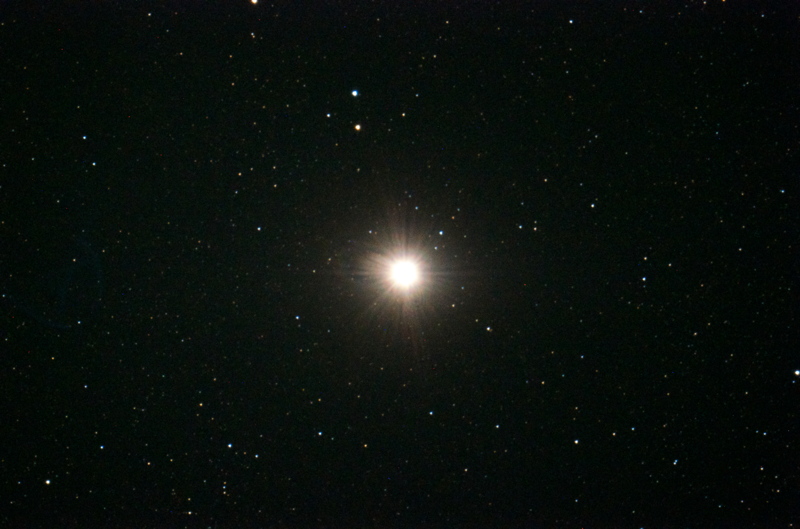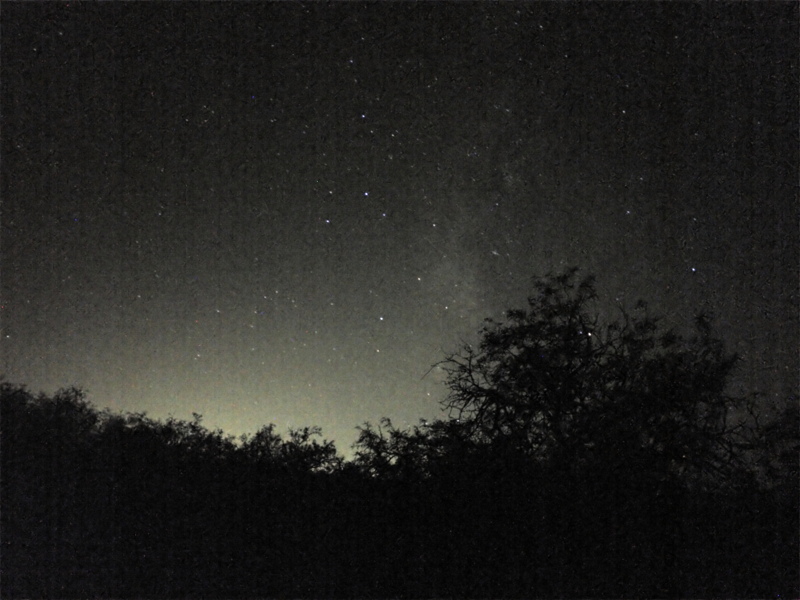Comet C/2013 A1 Siding Spring,
iPhone Milky Way, Neptune moon Triton
Posted: 14 October 2014
Did not open the observatory on Saturday as I represented the Oracle Dark Skies Committee at the last GLOW event of 2014. I had my ETX-105PE set up so visitors could experience telescope views of several objects. Sunday evening I gave a talk at a meeting of the Saddlebrooke Skygazers club on the work of the Committee and the impacts of light pollution. Prior to the meeting I was hosted at a dinner by officers of the club.
|
Opened: Monday, 13 October 2014, 1808 MST Temperature: 78°F |
Session: 728 Conditions: Clear |
1818 MST: viewed Saturn, 83X, very low in the southwest. Then did some more software beta testing, which was completed at 1834 MST. Next, viewed Mars, 83X; no details visible.
Began preparing for imaging Comet C/2013 A1 Siding Spring. Mounted the D7000 DSLR at prime focus of the 8" LX200-ACF. Did a focus test on Alpha Sagittarius using the Bahtinov Mask. Slewed to the comet using SkySafari Pro on the iPhone and the GC Wi-Fi Adapter. Took 1 minute unguided exposures at ISO 2500, ISO 4000, and ISO 6400 in an attempt to bring out more comet details than the shorter exposures taken on previous nights when I imaged multiple times to show the comet's motion. The ISO 6400 exposure, taken at 1902 MST, showed the most coma and tail of the comet, as seen in this slightly cropped image:

Since the comet is approaching Mars, I decided to try imaging Mars at the same exposure. Obviously overexposed:

1915 MST: ended Mars imaging and began trying to observe the comet at 83X. By IDing stars as shown in SkySafari Pro on the iPhone, I was able to locate the comet at 1921 MST. Coma was faint but larger than I saw it on the previous viewing (10 October). Using 222X, the comet was a difficult object but it was visible even without using averted vision. It was however very low in the southwestern sky by this time.
1931 MST: began doing some tests of the newly updated iOS app "NightCap Pro", which now supports using the Earbuds/Mic Volume Control as a remote shutter release. In addition, there are many new capabilities for long exposures. I did several photographs of the Milky Way with the iPhone 5s (iOS 8.0.2) mounted on a GorillaPod. This is a 30 second exposure:

2000 MST: ended sky photography. I plan to do more NCP sky photography.
2003 MST: viewed Neptune, 83X and 222X. Did not see the moon Triton visually. Mounted the D7000 DSLR at prime focus + 2X PowerMate and after doing a focus test on the star Fomalhaut, begin imaging the planet using various exposures. This 10 second, ISO 6400, best showed the moon Triton:

Mouseover or tap the image to view a pointer to Triton
2022 MST: ended Neptune imaging. Did some brief sky viewing using my 2X nightscope. Looked at the Milky Way, M31, the Double Cluster, and the Pleiades. Always interesting views with the amplified monocular.
2030 MST: did some sky quality measurements as a test of a new version of the iOS app Dark Sky Meter.
2101 MST: viewed the galaxy M74, 83X.
|
Closed: Monday, 13 October 2014, 2130 MST Temperature: 64°F |
|
Comments are welcome using Email. If you are on Twitter you can use the button below to tweet this report to your followers. Thanks.
Cassiopeia Observatory Home Page
Copyright ©2014 Michael L. Weasner / mweasner@me.com
URL = http://www.weasner.com/co/Reports/2014/10/14/index.html
